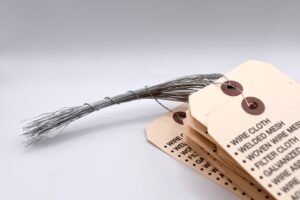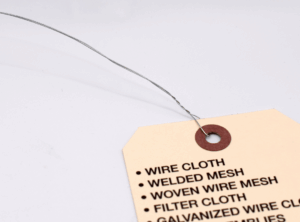Tag Wire: A Guide to Uses, Materials, and Applications
Key Points
- Tag wire, typically galvanized or stainless steel, is used for attaching tags or labels to objects.
- Tag wire is employed in retail, warehousing, manufacturing, and safety inspections.
- Typical sizes of Tag Wire include 23 and 26 gauge, with lengths such as 7.5″, 12″, or 18″.
- No specific standards govern tag wire; material choice depends on environmental conditions.
Introduction to Tag Wire
Tag wire is a versatile and essential tool designed to secure tags, labels, or lightweight items to various objects, streamlining organization, identification, and safety compliance across multiple industries. Crafted from galvanized steel or stainless steel, this specialized wire combines strength, durability, and flexibility, allowing it to be easily twisted or crimped without the need for tools. Available in pre-cut lengths such as 7.5″, 12″, or 18″, tag wire meets the diverse needs of retail, warehousing, manufacturing, and safety inspections, ensuring tags remain securely fastened and legible in a range of environments.
Materials and Properties
The performance of tag wire hinges on its material, which affects corrosion resistance and strength. Galvanized steel, coated with zinc, resists corrosion and is cost-effective for indoor or mildly corrosive environments, though the zinc may wear in harsh conditions, leading to rust. However, Stainless steel, with chromium, offers superior corrosion resistance, ideal for moist, salty, or chemically aggressive settings, but at a higher cost. Less common materials like aluminum or brass may be used for lightweight or decorative tagging.
Specifications and Sizes
Tag wire is available in various gauges and lengths. Common gauges include 18, 21, 23, and 26, with 23 and 26 preferred for lightweight tags due to their flexibility. Pre-cut lengths of 7.5″, 12″, or 18″ are standard, with 7.5″ suited for fire extinguisher tags and 12″ or 18″ for larger items. It is typically packaged in bundles of 500 or 1000 wires. Thinner gauges like 26 work well for lightweight tags in low-stress environments, while thicker gauges like 18 are better for heavier tags or applications needing greater strength. Shorter lengths suffice for small objects, while longer lengths accommodate larger items or multiple attachment points.
Applications
- Retail: In retail, tag wire secures price tags, promotional labels, or identification tags to clothing, accessories, or other merchandise. Its flexibility allows staff to quickly attach and remove tags, streamlining operations in busy stores. For this application, 23 or 26-gauge galvanized steel in 12″ lengths is commonly used due to its cost-effectiveness and ease of use in indoor environments. Stainless steel may be chosen for high-end merchandise exposed to handling or moisture.
- Warehousing: Tag wire is used in warehousing to label inventory, mark storage locations, or identify shipments, ensuring accurate tracking and reducing errors in large facilities. A typical choice is 23-gauge galvanized steel in 12″ or 18″ lengths, providing sufficient strength for securing tags to crates or pallets. In warehouses with high humidity, 26-gauge stainless steel may be preferred to prevent rust and maintain tag legibility.
- Manufacturing: In manufacturing, tag wire attaches tags to equipment for maintenance schedules, safety warnings, or product identification, supporting compliance with operational protocols. Thicker gauges like 21 or 18 in 12″ lengths are often used for durability, especially in heavy-duty settings. Stainless steel tag wire is recommended for environments with chemical exposure or frequent cleaning, ensuring tags remain secure and readable.
- Safety Compliance: Tag wire is critical for safety compliance, particularly for attaching inspection tags to fire extinguishers, as required by OSHA’s 29 CFR 1910.157 for monthly inspections. Galvanized steel, typically 26-gauge and 7.5″ long, is widely used for its affordability and reliability in indoor settings. Stainless steel in similar sizes may be used in corrosive environments to ensure long-term durability.
- Other Uses: Tag wire also finds use in agriculture for labeling produce and in marine settings for tagging traps, where stainless steel in 26-gauge, 12″ lengths is preferred for its resistance to saltwater corrosion. These applications require wire that withstands environmental challenges while securely holding tags.
Best Practices
To ensure effective use, twist or crimp tag wire tightly to prevent tag detachment without damaging the tag or object. Regularly inspect for rust or wear, especially in outdoor or corrosive environments, and replace as needed. Choose galvanized steel for mild, budget-conscious settings and stainless steel for high-moisture or salty conditions. For safety-critical applications like fire extinguisher tagging, ensure the wire’s durability aligns with regulations to keep tags secure and legible.
Standards and Regulations
No specific standards govern tag wire, but certain applications require compliance. OSHA’s 29 CFR 1910.157 mandates monthly fire extinguisher inspections, with tags secured by durable wire, often 26-gauge galvanized steel. In industrial settings, tags must remain legible and secure per internal or industry guidelines, such as those for electrical systems.
Conclusion
Sunset Wire’s tag wire, crafted from galvanized or stainless steel, is a versatile tool for labeling in retail, warehousing, manufacturing, and safety applications. Available in gauges like 23 or 26 and lengths from 7.5″ to 18″, it offers flexibility for diverse tasks. Galvanized steel is ideal for mild environments, while stainless steel excels in harsh conditions. By choosing the right material and size and following best practices, users can ensure tags remain secure and legible, boosting efficiency and compliance. Contact Sunset Wire for tailored tag wire solutions.